Motivation Report: Theories, Factors, and Coping Strategies
VerifiedAdded on 2023/06/05
|8
|1915
|353
Report
AI Summary
This report explores the multifaceted concept of motivation in the workplace, beginning with a definition of motivation and its importance in achieving both individual and organizational goals. It delves into Maslow's Hierarchy of Needs as a foundational theory, explaining how fulfilling different levels of needs impacts employee behavior and motivation. The report differentiates between extrinsic and intrinsic motivation, outlining factors that motivate employees such as salary, promotion, and a positive work environment. It also addresses both the positive (opportunities, flexibility) and negative factors (conflicts, poor management) that influence employee motivation, concluding with strategies organizations can implement to mitigate negative impacts and foster a more motivated workforce through communication, conflict resolution, and employee recognition.
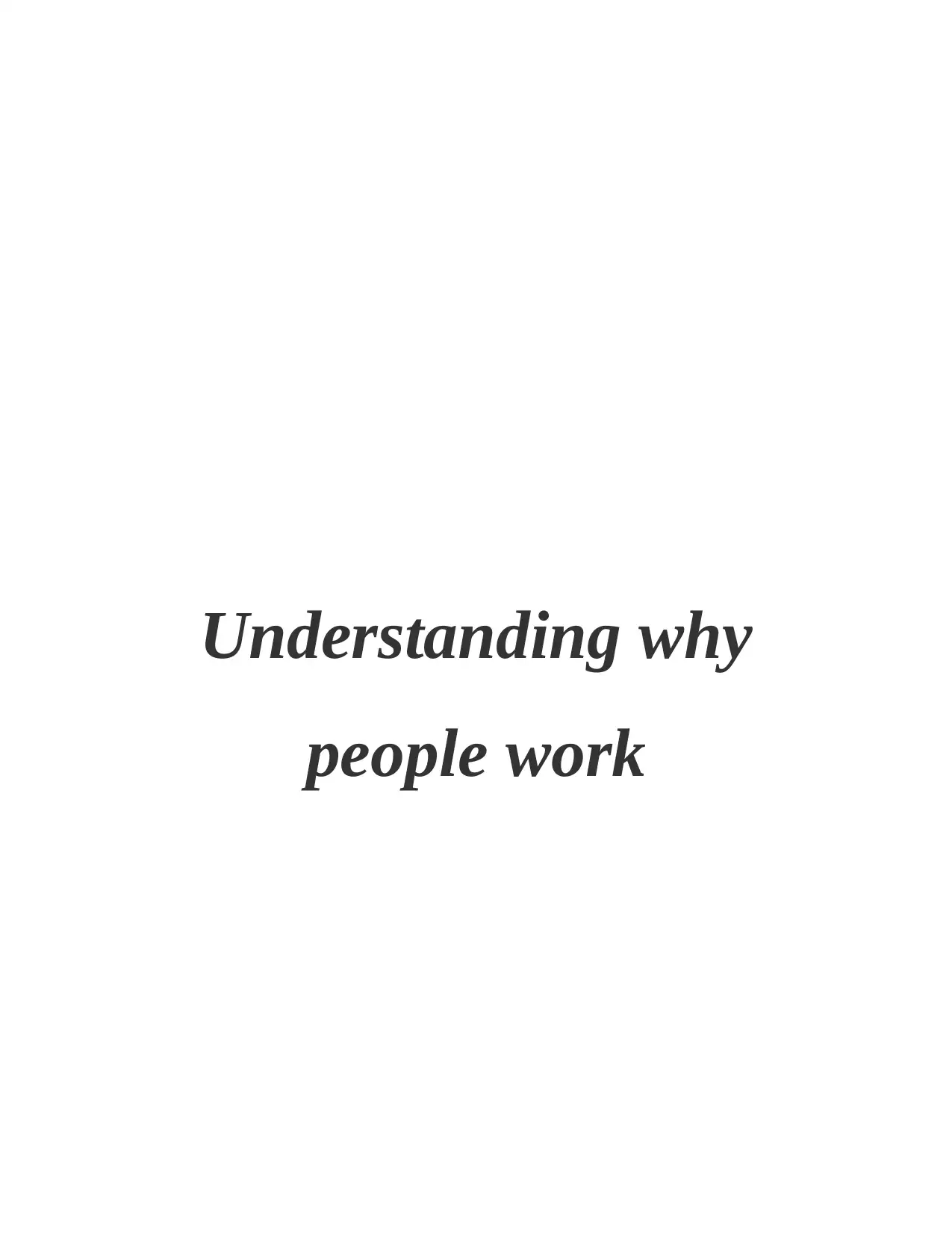
Understanding why
people work
people work
Paraphrase This Document
Need a fresh take? Get an instant paraphrase of this document with our AI Paraphraser
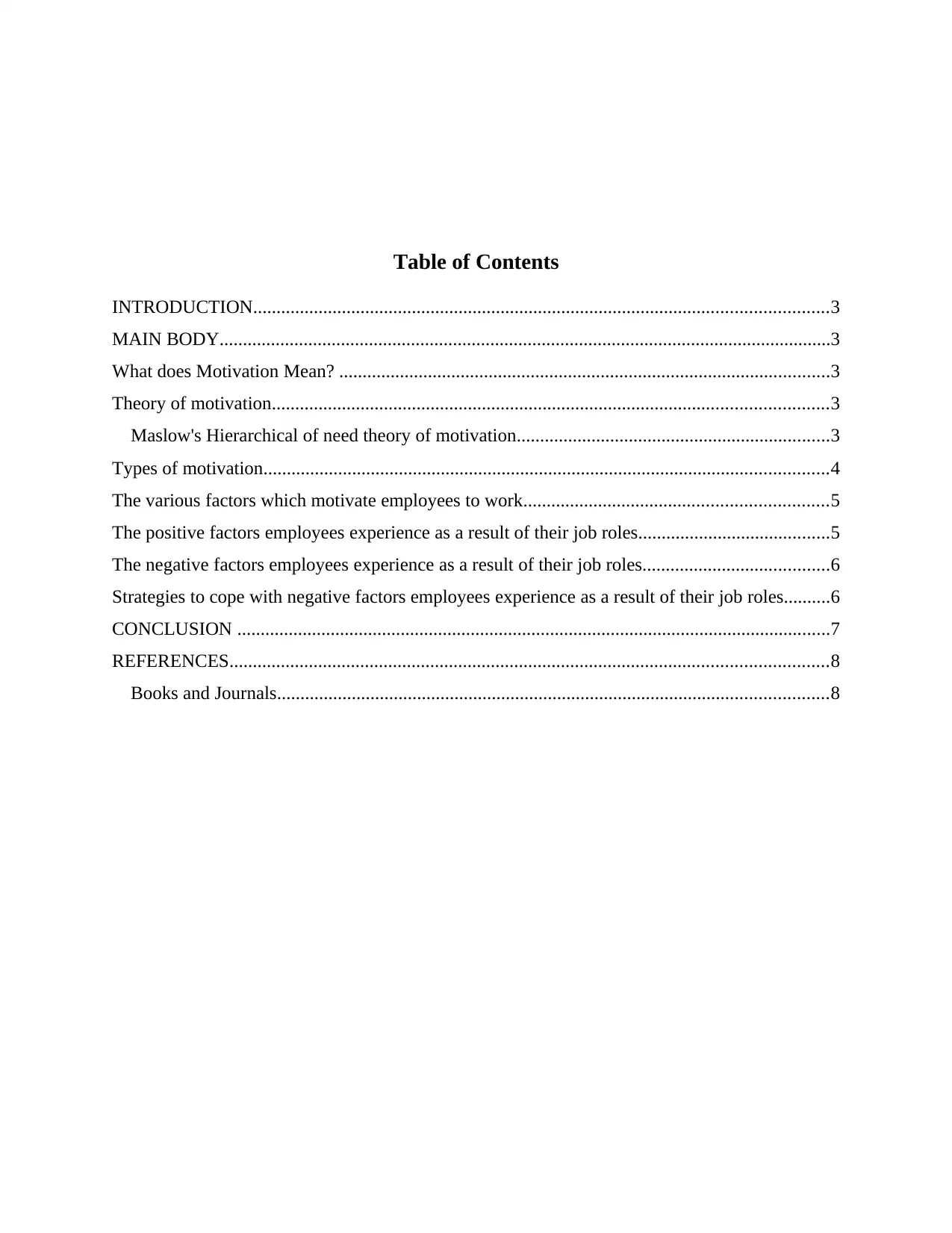
Table of Contents
INTRODUCTION...........................................................................................................................3
MAIN BODY...................................................................................................................................3
What does Motivation Mean? .........................................................................................................3
Theory of motivation.......................................................................................................................3
Maslow's Hierarchical of need theory of motivation...................................................................3
Types of motivation.........................................................................................................................4
The various factors which motivate employees to work.................................................................5
The positive factors employees experience as a result of their job roles.........................................5
The negative factors employees experience as a result of their job roles........................................6
Strategies to cope with negative factors employees experience as a result of their job roles..........6
CONCLUSION ...............................................................................................................................7
REFERENCES................................................................................................................................8
Books and Journals......................................................................................................................8
INTRODUCTION...........................................................................................................................3
MAIN BODY...................................................................................................................................3
What does Motivation Mean? .........................................................................................................3
Theory of motivation.......................................................................................................................3
Maslow's Hierarchical of need theory of motivation...................................................................3
Types of motivation.........................................................................................................................4
The various factors which motivate employees to work.................................................................5
The positive factors employees experience as a result of their job roles.........................................5
The negative factors employees experience as a result of their job roles........................................6
Strategies to cope with negative factors employees experience as a result of their job roles..........6
CONCLUSION ...............................................................................................................................7
REFERENCES................................................................................................................................8
Books and Journals......................................................................................................................8
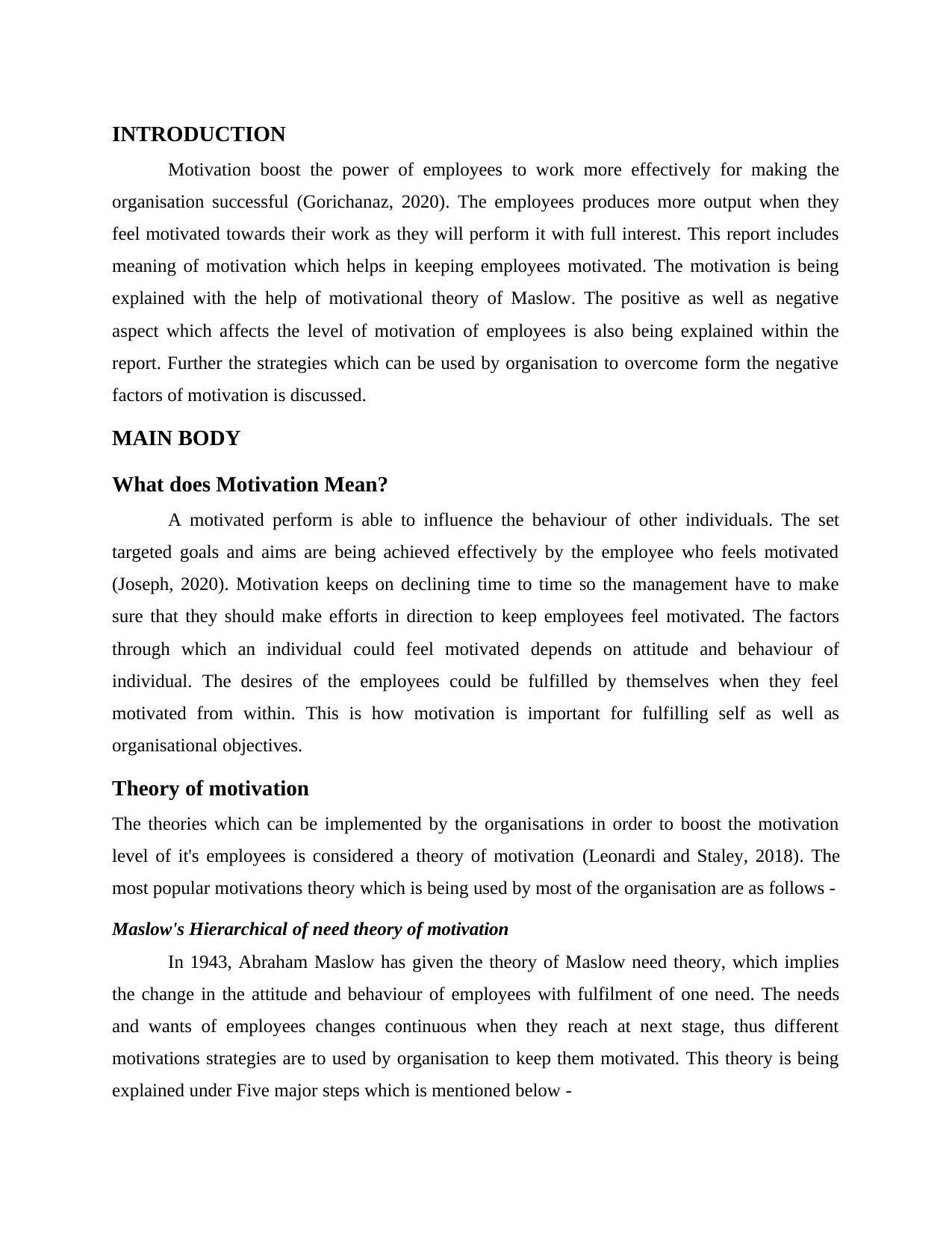
INTRODUCTION
Motivation boost the power of employees to work more effectively for making the
organisation successful (Gorichanaz, 2020). The employees produces more output when they
feel motivated towards their work as they will perform it with full interest. This report includes
meaning of motivation which helps in keeping employees motivated. The motivation is being
explained with the help of motivational theory of Maslow. The positive as well as negative
aspect which affects the level of motivation of employees is also being explained within the
report. Further the strategies which can be used by organisation to overcome form the negative
factors of motivation is discussed.
MAIN BODY
What does Motivation Mean?
A motivated perform is able to influence the behaviour of other individuals. The set
targeted goals and aims are being achieved effectively by the employee who feels motivated
(Joseph, 2020). Motivation keeps on declining time to time so the management have to make
sure that they should make efforts in direction to keep employees feel motivated. The factors
through which an individual could feel motivated depends on attitude and behaviour of
individual. The desires of the employees could be fulfilled by themselves when they feel
motivated from within. This is how motivation is important for fulfilling self as well as
organisational objectives.
Theory of motivation
The theories which can be implemented by the organisations in order to boost the motivation
level of it's employees is considered a theory of motivation (Leonardi and Staley, 2018). The
most popular motivations theory which is being used by most of the organisation are as follows -
Maslow's Hierarchical of need theory of motivation
In 1943, Abraham Maslow has given the theory of Maslow need theory, which implies
the change in the attitude and behaviour of employees with fulfilment of one need. The needs
and wants of employees changes continuous when they reach at next stage, thus different
motivations strategies are to used by organisation to keep them motivated. This theory is being
explained under Five major steps which is mentioned below -
Motivation boost the power of employees to work more effectively for making the
organisation successful (Gorichanaz, 2020). The employees produces more output when they
feel motivated towards their work as they will perform it with full interest. This report includes
meaning of motivation which helps in keeping employees motivated. The motivation is being
explained with the help of motivational theory of Maslow. The positive as well as negative
aspect which affects the level of motivation of employees is also being explained within the
report. Further the strategies which can be used by organisation to overcome form the negative
factors of motivation is discussed.
MAIN BODY
What does Motivation Mean?
A motivated perform is able to influence the behaviour of other individuals. The set
targeted goals and aims are being achieved effectively by the employee who feels motivated
(Joseph, 2020). Motivation keeps on declining time to time so the management have to make
sure that they should make efforts in direction to keep employees feel motivated. The factors
through which an individual could feel motivated depends on attitude and behaviour of
individual. The desires of the employees could be fulfilled by themselves when they feel
motivated from within. This is how motivation is important for fulfilling self as well as
organisational objectives.
Theory of motivation
The theories which can be implemented by the organisations in order to boost the motivation
level of it's employees is considered a theory of motivation (Leonardi and Staley, 2018). The
most popular motivations theory which is being used by most of the organisation are as follows -
Maslow's Hierarchical of need theory of motivation
In 1943, Abraham Maslow has given the theory of Maslow need theory, which implies
the change in the attitude and behaviour of employees with fulfilment of one need. The needs
and wants of employees changes continuous when they reach at next stage, thus different
motivations strategies are to used by organisation to keep them motivated. This theory is being
explained under Five major steps which is mentioned below -
⊘ This is a preview!⊘
Do you want full access?
Subscribe today to unlock all pages.

Trusted by 1+ million students worldwide
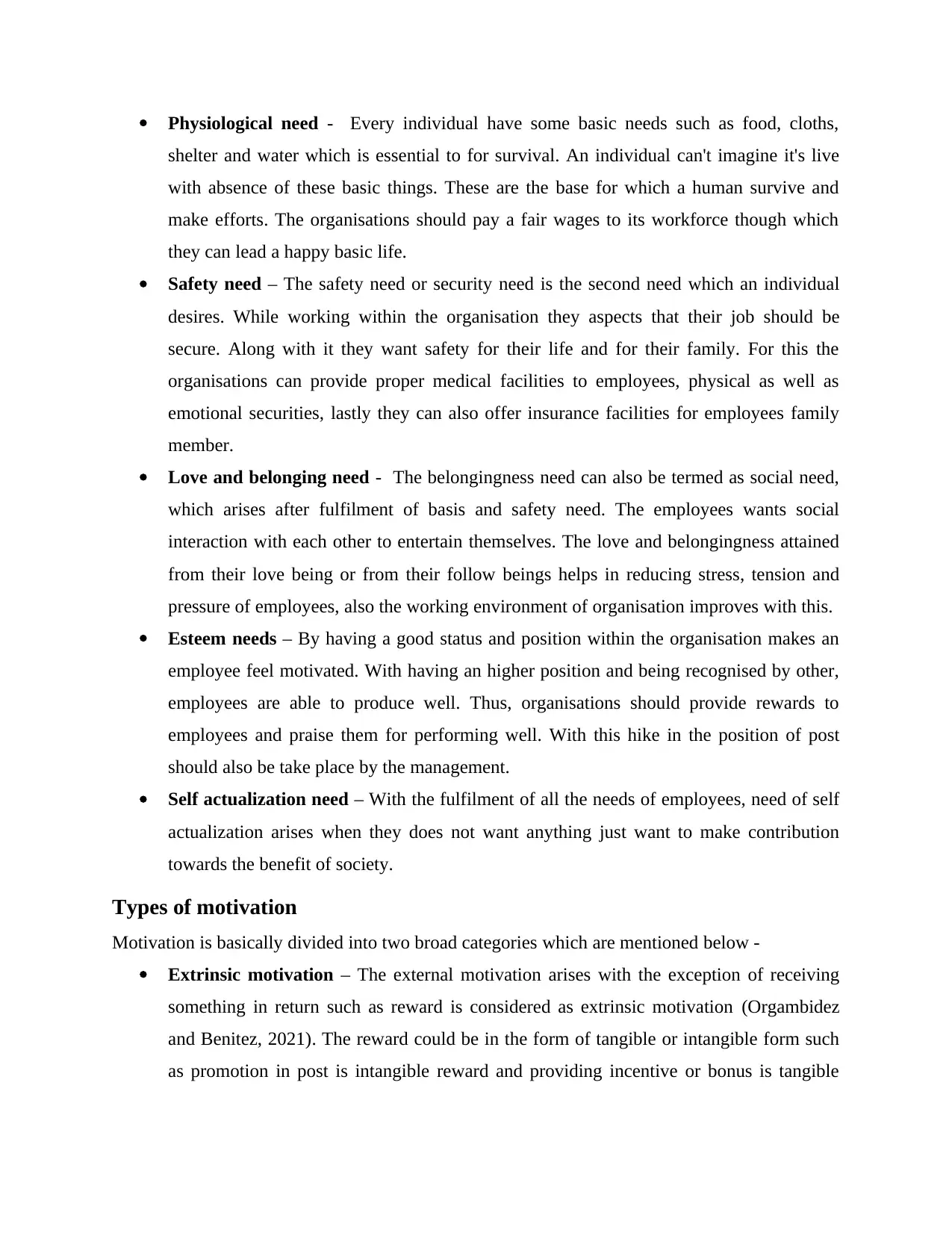
Physiological need - Every individual have some basic needs such as food, cloths,
shelter and water which is essential to for survival. An individual can't imagine it's live
with absence of these basic things. These are the base for which a human survive and
make efforts. The organisations should pay a fair wages to its workforce though which
they can lead a happy basic life.
Safety need – The safety need or security need is the second need which an individual
desires. While working within the organisation they aspects that their job should be
secure. Along with it they want safety for their life and for their family. For this the
organisations can provide proper medical facilities to employees, physical as well as
emotional securities, lastly they can also offer insurance facilities for employees family
member.
Love and belonging need - The belongingness need can also be termed as social need,
which arises after fulfilment of basis and safety need. The employees wants social
interaction with each other to entertain themselves. The love and belongingness attained
from their love being or from their follow beings helps in reducing stress, tension and
pressure of employees, also the working environment of organisation improves with this.
Esteem needs – By having a good status and position within the organisation makes an
employee feel motivated. With having an higher position and being recognised by other,
employees are able to produce well. Thus, organisations should provide rewards to
employees and praise them for performing well. With this hike in the position of post
should also be take place by the management.
Self actualization need – With the fulfilment of all the needs of employees, need of self
actualization arises when they does not want anything just want to make contribution
towards the benefit of society.
Types of motivation
Motivation is basically divided into two broad categories which are mentioned below -
Extrinsic motivation – The external motivation arises with the exception of receiving
something in return such as reward is considered as extrinsic motivation (Orgambidez
and Benitez, 2021). The reward could be in the form of tangible or intangible form such
as promotion in post is intangible reward and providing incentive or bonus is tangible
shelter and water which is essential to for survival. An individual can't imagine it's live
with absence of these basic things. These are the base for which a human survive and
make efforts. The organisations should pay a fair wages to its workforce though which
they can lead a happy basic life.
Safety need – The safety need or security need is the second need which an individual
desires. While working within the organisation they aspects that their job should be
secure. Along with it they want safety for their life and for their family. For this the
organisations can provide proper medical facilities to employees, physical as well as
emotional securities, lastly they can also offer insurance facilities for employees family
member.
Love and belonging need - The belongingness need can also be termed as social need,
which arises after fulfilment of basis and safety need. The employees wants social
interaction with each other to entertain themselves. The love and belongingness attained
from their love being or from their follow beings helps in reducing stress, tension and
pressure of employees, also the working environment of organisation improves with this.
Esteem needs – By having a good status and position within the organisation makes an
employee feel motivated. With having an higher position and being recognised by other,
employees are able to produce well. Thus, organisations should provide rewards to
employees and praise them for performing well. With this hike in the position of post
should also be take place by the management.
Self actualization need – With the fulfilment of all the needs of employees, need of self
actualization arises when they does not want anything just want to make contribution
towards the benefit of society.
Types of motivation
Motivation is basically divided into two broad categories which are mentioned below -
Extrinsic motivation – The external motivation arises with the exception of receiving
something in return such as reward is considered as extrinsic motivation (Orgambidez
and Benitez, 2021). The reward could be in the form of tangible or intangible form such
as promotion in post is intangible reward and providing incentive or bonus is tangible
Paraphrase This Document
Need a fresh take? Get an instant paraphrase of this document with our AI Paraphraser

reward. To keep employees motivated and to get back to track organisations should
provide timely incentives to it's workforce.
Intrinsic motivation – The employees made efforts to direction to fulfill it's personal
need this is why they feels motivated is considered as intrinsic motivation. They made
full efforts to achieve it's personal goals and are not involved in fulfilling organisational
goals.
The various factors which motivate employees to work
The employees will work with full motivation by the implementation of certain factors by
management within the organisation (Rikala, 2020). The most important factors requires to make
employees feel motivated are as follows -
Salary – The salary is the most important factor for which the employees put efforts to
join the organisation. The salary is the basic need which is essential for living a standard
life. The employees should be paid with fair wages in order to boost their motivation. For
the better and effective performance the management should also provide hike in their
salaries otherwise they will switch in other companies for the sake of getting higher pay.
Thus, organisation have to make extra efforts to make new hiring and increase in
unwanted cost takes place.
Promotion – When the employee is a good performer and is achieving it's all gaols on
decided time line with full accuracy then they should be praised. They can provided with
some incentives, bonus or they can promote that employee to higher position to keep
them feel motivated and also to recognise them.
Work Environment – The positive working environment provided by the
management boost the productivity of employees to make extra efforts. The mental
condition of employees keeps stable by having an healthy and positive working culture
present within the organisation.
The positive factors employees experience as a result of their job roles
The positive factor which helps in keeping the workforce motivated while performing the
work are as follows -
provide timely incentives to it's workforce.
Intrinsic motivation – The employees made efforts to direction to fulfill it's personal
need this is why they feels motivated is considered as intrinsic motivation. They made
full efforts to achieve it's personal goals and are not involved in fulfilling organisational
goals.
The various factors which motivate employees to work
The employees will work with full motivation by the implementation of certain factors by
management within the organisation (Rikala, 2020). The most important factors requires to make
employees feel motivated are as follows -
Salary – The salary is the most important factor for which the employees put efforts to
join the organisation. The salary is the basic need which is essential for living a standard
life. The employees should be paid with fair wages in order to boost their motivation. For
the better and effective performance the management should also provide hike in their
salaries otherwise they will switch in other companies for the sake of getting higher pay.
Thus, organisation have to make extra efforts to make new hiring and increase in
unwanted cost takes place.
Promotion – When the employee is a good performer and is achieving it's all gaols on
decided time line with full accuracy then they should be praised. They can provided with
some incentives, bonus or they can promote that employee to higher position to keep
them feel motivated and also to recognise them.
Work Environment – The positive working environment provided by the
management boost the productivity of employees to make extra efforts. The mental
condition of employees keeps stable by having an healthy and positive working culture
present within the organisation.
The positive factors employees experience as a result of their job roles
The positive factor which helps in keeping the workforce motivated while performing the
work are as follows -
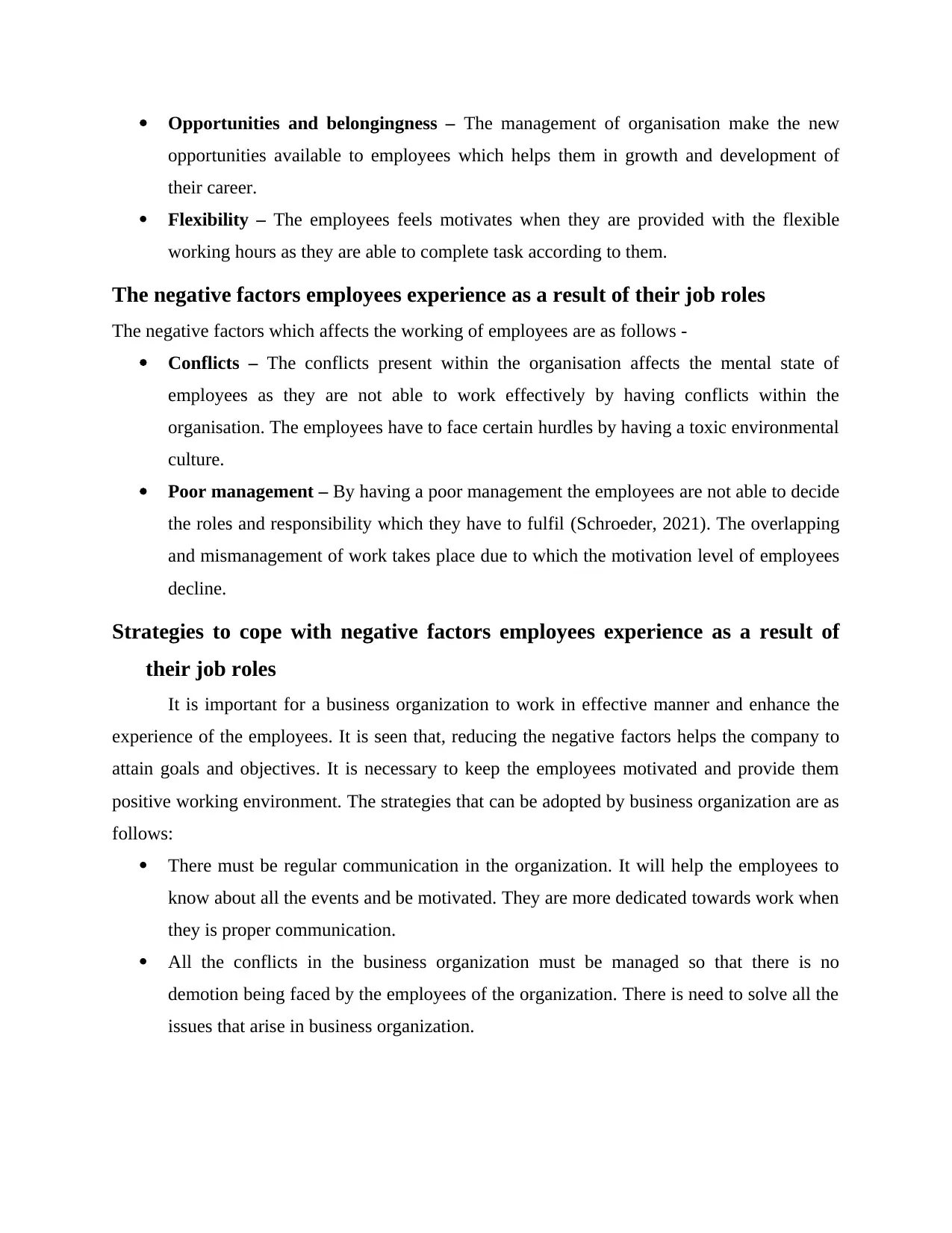
Opportunities and belongingness – The management of organisation make the new
opportunities available to employees which helps them in growth and development of
their career.
Flexibility – The employees feels motivates when they are provided with the flexible
working hours as they are able to complete task according to them.
The negative factors employees experience as a result of their job roles
The negative factors which affects the working of employees are as follows -
Conflicts – The conflicts present within the organisation affects the mental state of
employees as they are not able to work effectively by having conflicts within the
organisation. The employees have to face certain hurdles by having a toxic environmental
culture.
Poor management – By having a poor management the employees are not able to decide
the roles and responsibility which they have to fulfil (Schroeder, 2021). The overlapping
and mismanagement of work takes place due to which the motivation level of employees
decline.
Strategies to cope with negative factors employees experience as a result of
their job roles
It is important for a business organization to work in effective manner and enhance the
experience of the employees. It is seen that, reducing the negative factors helps the company to
attain goals and objectives. It is necessary to keep the employees motivated and provide them
positive working environment. The strategies that can be adopted by business organization are as
follows:
There must be regular communication in the organization. It will help the employees to
know about all the events and be motivated. They are more dedicated towards work when
they is proper communication.
All the conflicts in the business organization must be managed so that there is no
demotion being faced by the employees of the organization. There is need to solve all the
issues that arise in business organization.
opportunities available to employees which helps them in growth and development of
their career.
Flexibility – The employees feels motivates when they are provided with the flexible
working hours as they are able to complete task according to them.
The negative factors employees experience as a result of their job roles
The negative factors which affects the working of employees are as follows -
Conflicts – The conflicts present within the organisation affects the mental state of
employees as they are not able to work effectively by having conflicts within the
organisation. The employees have to face certain hurdles by having a toxic environmental
culture.
Poor management – By having a poor management the employees are not able to decide
the roles and responsibility which they have to fulfil (Schroeder, 2021). The overlapping
and mismanagement of work takes place due to which the motivation level of employees
decline.
Strategies to cope with negative factors employees experience as a result of
their job roles
It is important for a business organization to work in effective manner and enhance the
experience of the employees. It is seen that, reducing the negative factors helps the company to
attain goals and objectives. It is necessary to keep the employees motivated and provide them
positive working environment. The strategies that can be adopted by business organization are as
follows:
There must be regular communication in the organization. It will help the employees to
know about all the events and be motivated. They are more dedicated towards work when
they is proper communication.
All the conflicts in the business organization must be managed so that there is no
demotion being faced by the employees of the organization. There is need to solve all the
issues that arise in business organization.
⊘ This is a preview!⊘
Do you want full access?
Subscribe today to unlock all pages.

Trusted by 1+ million students worldwide
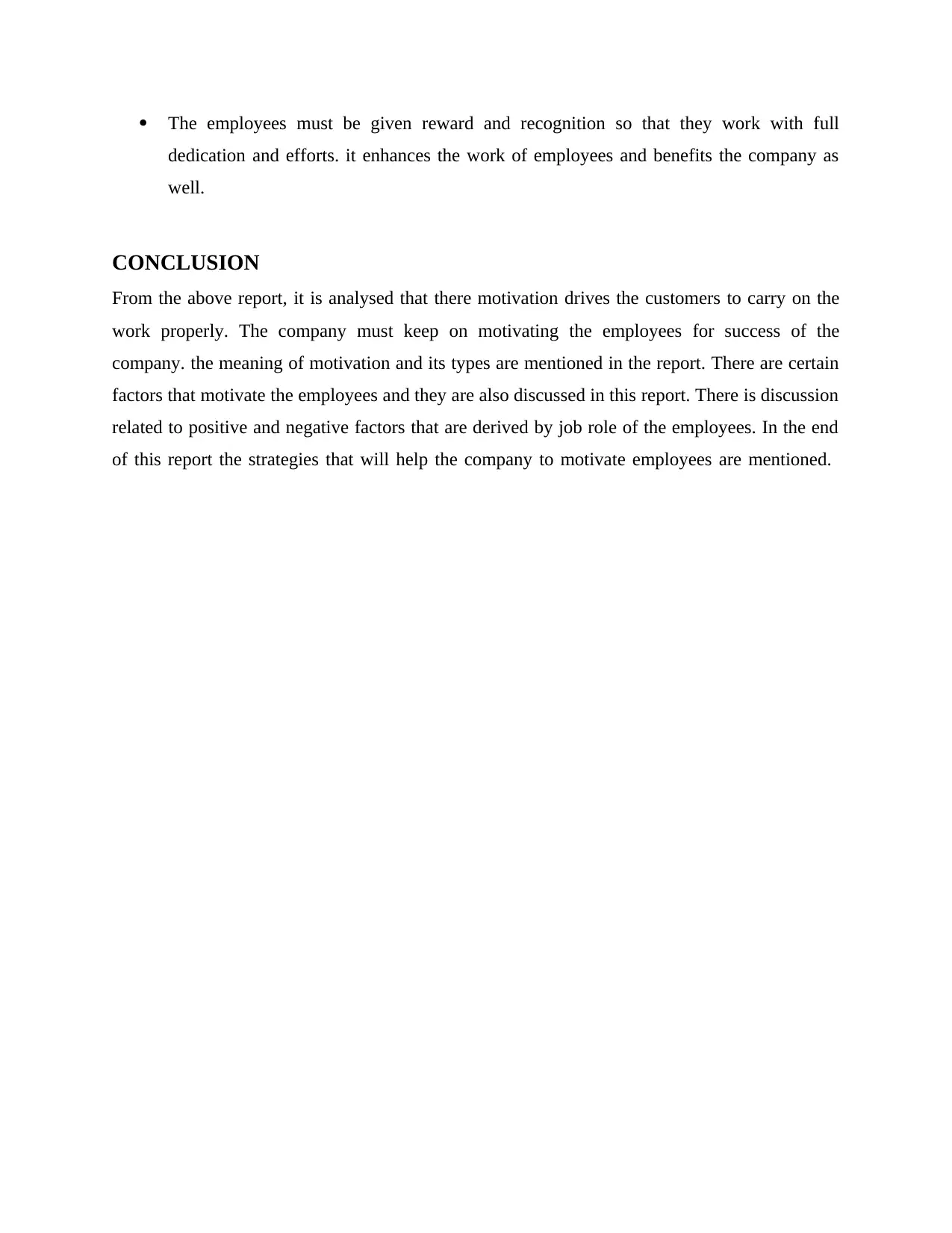
The employees must be given reward and recognition so that they work with full
dedication and efforts. it enhances the work of employees and benefits the company as
well.
CONCLUSION
From the above report, it is analysed that there motivation drives the customers to carry on the
work properly. The company must keep on motivating the employees for success of the
company. the meaning of motivation and its types are mentioned in the report. There are certain
factors that motivate the employees and they are also discussed in this report. There is discussion
related to positive and negative factors that are derived by job role of the employees. In the end
of this report the strategies that will help the company to motivate employees are mentioned.
dedication and efforts. it enhances the work of employees and benefits the company as
well.
CONCLUSION
From the above report, it is analysed that there motivation drives the customers to carry on the
work properly. The company must keep on motivating the employees for success of the
company. the meaning of motivation and its types are mentioned in the report. There are certain
factors that motivate the employees and they are also discussed in this report. There is discussion
related to positive and negative factors that are derived by job role of the employees. In the end
of this report the strategies that will help the company to motivate employees are mentioned.
Paraphrase This Document
Need a fresh take? Get an instant paraphrase of this document with our AI Paraphraser
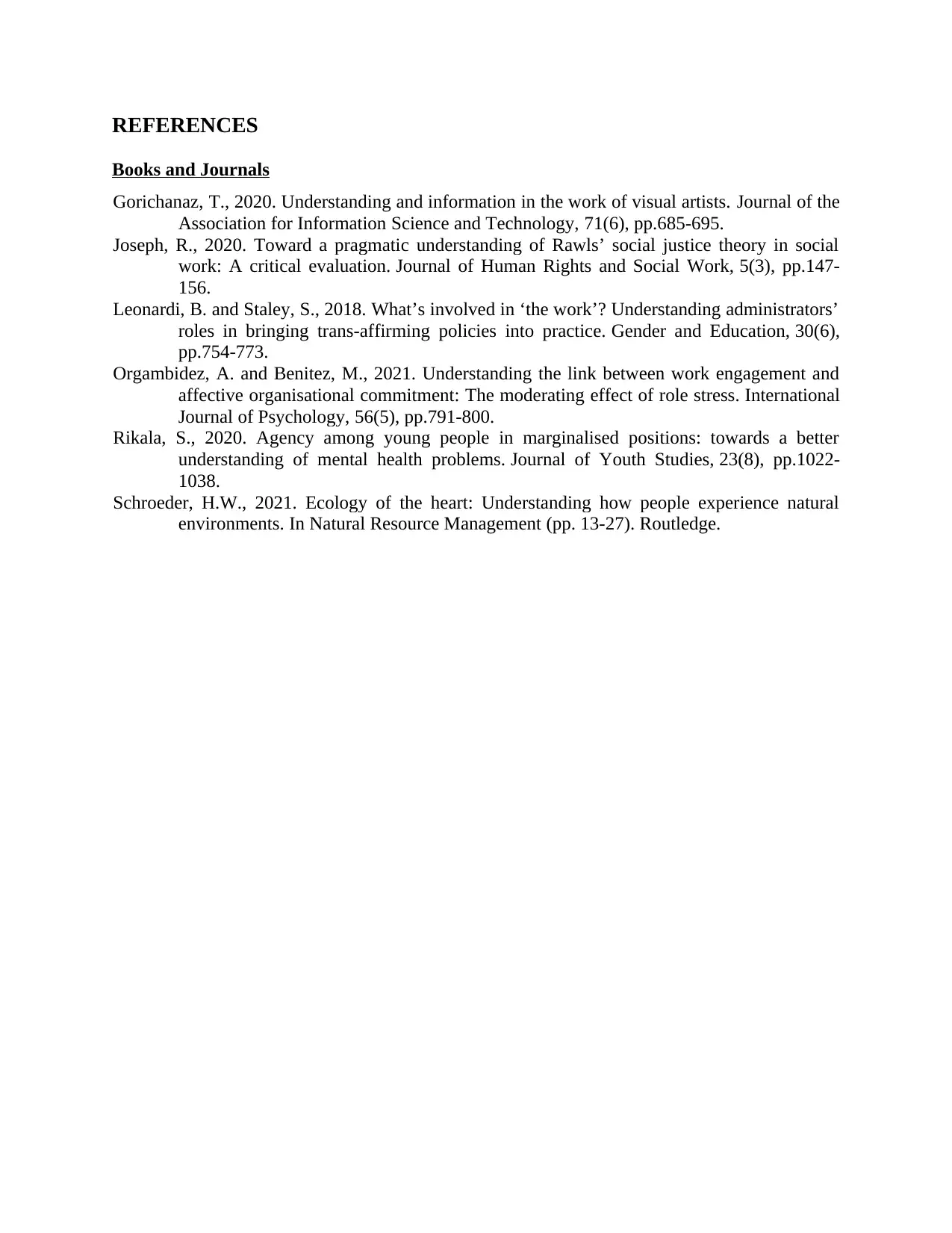
REFERENCES
Books and Journals
Gorichanaz, T., 2020. Understanding and information in the work of visual artists. Journal of the
Association for Information Science and Technology, 71(6), pp.685-695.
Joseph, R., 2020. Toward a pragmatic understanding of Rawls’ social justice theory in social
work: A critical evaluation. Journal of Human Rights and Social Work, 5(3), pp.147-
156.
Leonardi, B. and Staley, S., 2018. What’s involved in ‘the work’? Understanding administrators’
roles in bringing trans-affirming policies into practice. Gender and Education, 30(6),
pp.754-773.
Orgambidez, A. and Benitez, M., 2021. Understanding the link between work engagement and
affective organisational commitment: The moderating effect of role stress. International
Journal of Psychology, 56(5), pp.791-800.
Rikala, S., 2020. Agency among young people in marginalised positions: towards a better
understanding of mental health problems. Journal of Youth Studies, 23(8), pp.1022-
1038.
Schroeder, H.W., 2021. Ecology of the heart: Understanding how people experience natural
environments. In Natural Resource Management (pp. 13-27). Routledge.
Books and Journals
Gorichanaz, T., 2020. Understanding and information in the work of visual artists. Journal of the
Association for Information Science and Technology, 71(6), pp.685-695.
Joseph, R., 2020. Toward a pragmatic understanding of Rawls’ social justice theory in social
work: A critical evaluation. Journal of Human Rights and Social Work, 5(3), pp.147-
156.
Leonardi, B. and Staley, S., 2018. What’s involved in ‘the work’? Understanding administrators’
roles in bringing trans-affirming policies into practice. Gender and Education, 30(6),
pp.754-773.
Orgambidez, A. and Benitez, M., 2021. Understanding the link between work engagement and
affective organisational commitment: The moderating effect of role stress. International
Journal of Psychology, 56(5), pp.791-800.
Rikala, S., 2020. Agency among young people in marginalised positions: towards a better
understanding of mental health problems. Journal of Youth Studies, 23(8), pp.1022-
1038.
Schroeder, H.W., 2021. Ecology of the heart: Understanding how people experience natural
environments. In Natural Resource Management (pp. 13-27). Routledge.
1 out of 8
Related Documents
Your All-in-One AI-Powered Toolkit for Academic Success.
+13062052269
info@desklib.com
Available 24*7 on WhatsApp / Email
![[object Object]](/_next/static/media/star-bottom.7253800d.svg)
Unlock your academic potential
Copyright © 2020–2025 A2Z Services. All Rights Reserved. Developed and managed by ZUCOL.



